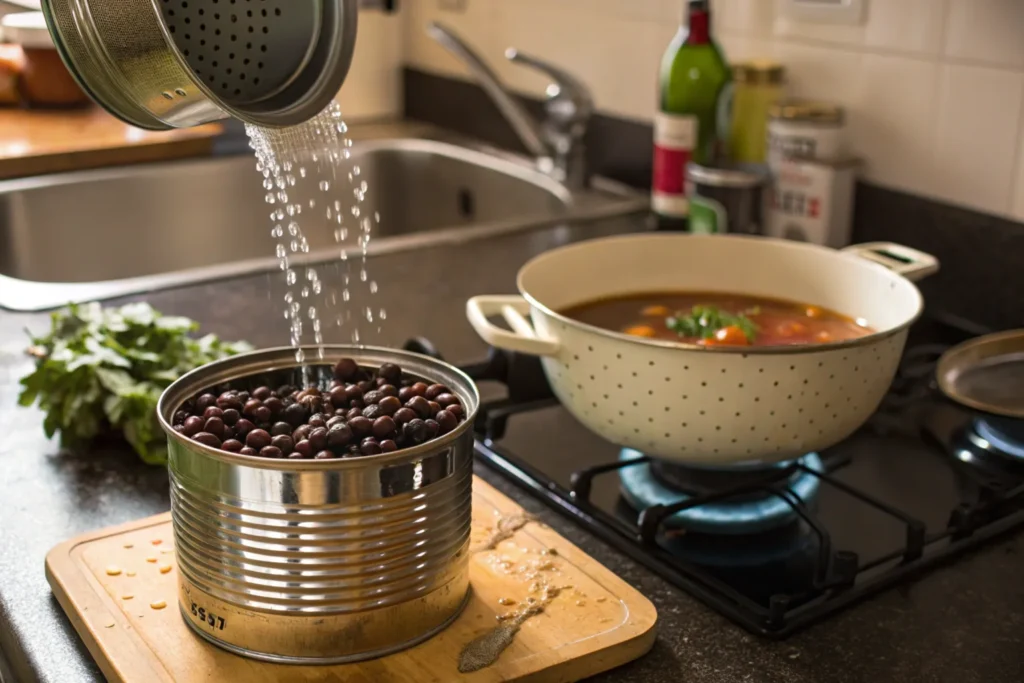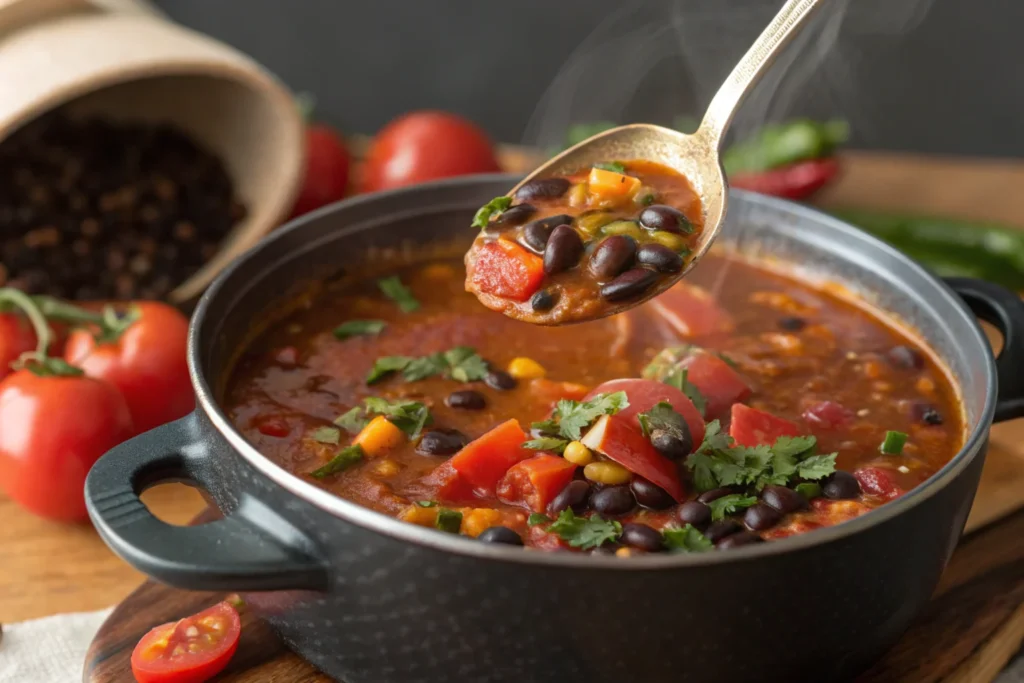Making a soup with black beans is one of those things that seems easy—until you get to that moment where you pause and think, “Wait, should I drain these beans first?” It’s such a simple step, but it stirs up a lot of debate. Some say yes, others say no, and honestly, both have valid reasons. Let’s dig into the details and figure out what works best for your soup.
What Makes Black Beans Unique in Soups?
Black beans are the ultimate pantry hero, especially for soups. They bring so much to the table—taste, texture, and nutrition—that it’s no wonder they’re a favorite in all kinds of cuisines. But what sets them apart when it comes to soups?
The Taste and Texture of Black Beans
Black beans have a mild, earthy flavor that’s incredibly versatile. Whether you’re making a spicy chili or a smoky, Cuban-style soup, they soak up the flavors of whatever you cook them with. Their creamy texture also makes soups feel rich and hearty without the need for cream or other thickeners.
Take, for example, a recipe like this classic black bean soup. The magic happens when the beans blend perfectly with the spices and aromatics—it’s a cozy bowl of deliciousness every time.
Nutritional Benefits of Black Beans in Soups
Black beans are not just tasty—they’re a nutritional powerhouse. Packed with fiber, protein, and essential vitamins, they’re a great way to make your soup more filling and balanced. Plus, they’re low in fat and high in antioxidants, making them a heart-healthy choice.
If you’re meal-prepping or trying to eat a little cleaner, adding black beans to your soup is an easy win.
Why Black Beans Are a Soup Staple
They’re affordable, easy to find, and ridiculously versatile. From a light soup on a summer evening to a hearty winter chili, black beans can do it all. Plus, canned black beans make it so convenient to whip up something delicious without hours of prep work.
To Drain or Not to Drain: The Great Debate
Here’s where things get interesting. Should you drain the liquid from your canned black beans before adding them to soup, or toss it all in? There’s no universal rule here—it all depends on your recipe, preferences, and what you’re aiming for. Let’s break down the pros and cons.

Pros of Draining Black Beans
- Removes Excess Salt and Preservatives
Canned beans often come packed in a salty liquid to help preserve them. Draining and rinsing the beans can significantly reduce the sodium content, which is great if you’re watching your salt intake or trying to create a more balanced dish. - Reduces Cloudiness in the Soup Broth
If you’re making a soup with a clear or light broth, like a vegetable or chicken soup, draining the beans helps keep the broth clean and visually appealing. The liquid in canned beans is starchy and dark, which might not be ideal for these types of recipes.
Cons of Draining Black Beans
- Loses Flavorful Bean Liquid
The thick liquid in the can isn’t just water—it’s packed with the starchy, slightly salty essence of the beans. This liquid can add depth and richness to your soup, acting almost like a natural stock. For recipes like chili or a hearty black bean soup, that extra flavor might be just what you need. - Wastes Nutritional Content
Some of the nutrients from the beans, like protein and fiber, leach into the liquid during the canning process. Draining and rinsing the beans means losing some of those valuable nutrients.
When to Drain Black Beans for Soup
Deciding whether to drain your black beans often comes down to the recipe. Some soups benefit from the clean, drained beans, while others thrive on the starchy richness of the liquid. Here’s how to decide.
Soups That Require Draining Canned Black Beans
If your recipe has a clear broth or delicate flavors, draining the beans is usually the way to go. Soups like vegetable minestrone or a light tortilla soup rely on their vibrant ingredients and a clean broth. The starchy liquid from canned beans could cloud the broth and overpower the flavors.
Think of it like this: When you’re making something light and fresh, like this Asian cucumber salad, you want the flavors to shine without unnecessary extras. The same principle applies here.
When to Use the Liquid from Canned Black Beans
For thicker, creamier soups, the liquid in canned beans can be a game-changer. That starchy goodness acts as a natural thickener and brings extra flavor to the pot.
For example, in a black bean chili or a Cuban black bean soup, keeping the liquid enhances the richness of the dish. It’s a bit like making a Million Dollar Chicken Casserole, where every element adds depth and complexity to the final dish.
Tips for Using Canned Black Beans in Soups
Canned black beans are a lifesaver for busy cooks, but how you handle them can make all the difference in your final dish. Whether you’re team “drain” or team “no-drain,” these tips will help you get the most out of your beans.

How to Properly Drain and Rinse Canned Black Beans
If you’ve decided to drain your black beans, here’s how to do it the right way:
- Use a Colander: Pour the beans into a colander or sieve.
- Rinse with Cold Water: Run cold water over the beans, gently shaking the colander to wash away the liquid and any excess sodium.
- Let Them Drain: Give the colander a minute or two to drain completely before adding the beans to your soup.
This step is especially helpful for reducing sodium or if you’re aiming for a clear broth.
Using Bean Liquid in Soups Without Overpowering the Flavor
Want to use the bean liquid but not sure how much? Start by adding small amounts to your soup and taste-testing as you go.
- For thick soups, like black bean chili, add the liquid gradually to control the thickness.
- If the flavor feels too intense, balance it out with a splash of acidity, like lime juice or apple cider vinegar. This works similarly to adjusting flavors in dishes like Jiffy Cornbread Dressing, where small tweaks make a big difference.
Combining Both Methods
Here’s a pro tip: If you’re undecided, try draining half the beans and keeping the liquid from the other half. This gives you the best of both worlds—clean flavors and a hint of starchy richness.
Homemade Black Beans: A Better Option?
While canned black beans are convenient, cooking black beans from scratch can take your soup to the next level. It might take a little more time, but the flavor, texture, and control you gain are totally worth it.

Why Homemade Black Beans Work Well in Soups
- Control Over Ingredients
When you cook black beans at home, you can control the amount of salt, spices, and seasonings. No preservatives, no surprises—just pure, wholesome beans. - Better Texture
Homemade black beans have a firmer texture than canned ones, making them ideal for soups where you want the beans to hold their shape. - Cost-Effective
Let’s face it, dried beans are incredibly affordable. A single bag can make multiple batches, saving you money in the long run. - Customizable Flavor
Simmering beans with aromatics like garlic, onions, bay leaves, or even a smoked ham hock infuses them with layers of flavor. Imagine using those beans in a hearty soup—it’s like building a flavor bomb from scratch.
Saving Cooking Liquid from Homemade Black Beans
The liquid you get from cooking dried beans (sometimes called aquafaba) is pure gold. It’s rich, starchy, and perfect for thickening soups or adding depth to stews.
For recipes that need extra richness—like a runny cornbread dressing fix—this liquid can work wonders. You can even freeze the leftover bean liquid in ice cube trays for future use.
Expert Opinions: Should You Drain Black Beans Before Cooking Soup?
If you’re still torn on whether to drain black beans for soup, you’re not alone. Chefs and nutritionists have weighed in on this debate, and their insights might just help you decide.
Chef Insights on Draining vs. Not Draining Black Beans
Most chefs agree that it depends on the dish. For light and brothy soups, draining the beans helps keep the flavors crisp and the broth clean. But for hearty soups, like a classic black bean chili, chefs often use the liquid to thicken the base and enhance the flavor.
In other words, it’s all about what you’re going for. A dish like this Million Dollar Chicken Casserole thrives on layering flavors, and using the bean liquid can offer a similar effect in soups.
Nutritionists on Using Canned Black Bean Liquid in Soups
From a health perspective, nutritionists suggest draining and rinsing if you’re trying to reduce sodium. Rinsing canned beans can cut the sodium content by up to 40%, which is significant if you’re watching your salt intake.
On the flip side, if sodium isn’t a concern, keeping the liquid means you’ll retain more nutrients, like fiber and protein, that might otherwise go down the drain. It’s a matter of balancing your nutritional needs with the flavor you want.
FAQs: Should You Drain Black Beans for Soup?
It depends on the recipe. If you want a lighter, cleaner flavor, draining and rinsing canned black beans is a good idea. But if you’re making a thicker soup or chili, the liquid can add flavor and richness.
In most cases, yes—especially if the soup has a clear broth or delicate flavors. Draining helps avoid clouding the broth. However, for hearty soups like black bean soup, keeping the liquid can enhance the dish’s texture and taste.
Yes, the liquid in canned black beans is safe to eat. It’s just water, salt, and starches from the beans. While it can be flavorful, it’s also high in sodium, so use it sparingly if you’re watching your salt intake.
Absolutely! The liquid is a natural thickener and can add depth to your soup. For recipes like chili or black bean soup, it’s a great way to boost flavor and texture without extra ingredients.
It might. The liquid contains oligosaccharides, a type of carbohydrate that can cause gas for some people. Draining and rinsing the beans helps remove these compounds and makes them easier to digest.
If you’re cooking black beans from scratch, you don’t have to drain them unless your recipe calls for it. The cooking liquid is flavorful and can be used in soups, stews, or even sauces for an extra boost of taste.
Conclusion
So, should you drain black beans for soup? Honestly, it comes down to the kind of soup you’re making and your personal taste. If you want a lighter broth or are keeping an eye on sodium, draining and rinsing the beans is your best bet. But if you’re making a thick, hearty soup, that starchy liquid can add flavor, richness, and a creamy texture.
The beauty of cooking is that it’s all about experimenting. Try it both ways, see what you like, and make it your own. Whether you’re whipping up a cozy black bean soup or adding beans to a chili, trust your instincts and don’t be afraid to get creative. After all, there’s no “wrong” way to do it—just what tastes best to you.


3 thoughts on “Should You Drain Black Beans for Soup?”
Comments are closed.